» posted on Thursday, September 19th, 2013 by Linda Lou Burton
All The Boxes
 Linda Burton posting from Augusta, Maine – If I could buy a state, I think I’d pick Maine. Now don’t get me wrong, I love all the states; some of them for their mountains, some for their shorelines, and some because they grow the food that feeds us. Some states are interesting because of their history; some are pleasant because of a great climate. Recreational opportunities, cultural activities, community spirit – all these things factor into how much we appreciate a place. And it seems to me that Maine ticks all the boxes. I’ve spent the afternoon poring over literature about Augusta so I could tell you what makes this capital city special. One thing is Fort Western, the oldest wooden fort in New England; it dates back to
Linda Burton posting from Augusta, Maine – If I could buy a state, I think I’d pick Maine. Now don’t get me wrong, I love all the states; some of them for their mountains, some for their shorelines, and some because they grow the food that feeds us. Some states are interesting because of their history; some are pleasant because of a great climate. Recreational opportunities, cultural activities, community spirit – all these things factor into how much we appreciate a place. And it seems to me that Maine ticks all the boxes. I’ve spent the afternoon poring over literature about Augusta so I could tell you what makes this capital city special. One thing is Fort Western, the oldest wooden fort in New England; it dates back to 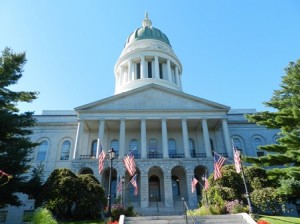 1754. I can’t wait to spend an afternoon there. And I look forward to my visit to the Maine State House – the cornerstone was laid in 1829 and the original designer was Charles Bulfinch, one of the most well-known architects of his time. The Blaine House is another beautiful historic building; it is now the Governor’s Mansion but was built as a family home by a ship’s captain in 1833 and donated to the state in 1919; there are gardens to tour as well. The Lithgow Library opened its doors to the community in 1894 and is considered one of the most
1754. I can’t wait to spend an afternoon there. And I look forward to my visit to the Maine State House – the cornerstone was laid in 1829 and the original designer was Charles Bulfinch, one of the most well-known architects of his time. The Blaine House is another beautiful historic building; it is now the Governor’s Mansion but was built as a family home by a ship’s captain in 1833 and donated to the state in 1919; there are gardens to tour as well. The Lithgow Library opened its doors to the community in 1894 and is considered one of the most 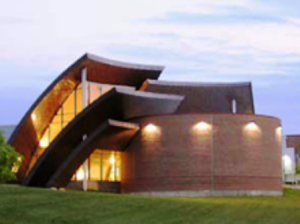 beautiful interior spaces in the state. I’m intrigued by the Holocaust and Human Rights Center in Augusta; it’s part of the University of Maine campus. It opened in 2007 and attracts national and international speakers; the University now offers a Minor in Holocaust, Genocide, and Human Rights Studies – the only program of its kind in the United States. But the most special thing about Augusta is simply that it’s in Maine.
beautiful interior spaces in the state. I’m intrigued by the Holocaust and Human Rights Center in Augusta; it’s part of the University of Maine campus. It opened in 2007 and attracts national and international speakers; the University now offers a Minor in Holocaust, Genocide, and Human Rights Studies – the only program of its kind in the United States. But the most special thing about Augusta is simply that it’s in Maine.
 I mean, seriously. Maine has 542,629 acres of state and national parks, such as Acadia National Park (the second most visited NP in the US) and Baxter State Park; that’s where Mt Katahdin is, and the very beginning of the 2,200-mile Appalachian Trail. Maine has 6,000 lakes and ponds, 32,000 miles of rivers and streams, 5,500 miles of coastline, and 2,000 islands. There are 65 lighthouses in Maine, one commissioned by George Washington. And Maine claims America’s first chartered city – York, 1641. Maine is America’s largest wild blueberry-growing state (raising 98% of the lowbush
I mean, seriously. Maine has 542,629 acres of state and national parks, such as Acadia National Park (the second most visited NP in the US) and Baxter State Park; that’s where Mt Katahdin is, and the very beginning of the 2,200-mile Appalachian Trail. Maine has 6,000 lakes and ponds, 32,000 miles of rivers and streams, 5,500 miles of coastline, and 2,000 islands. There are 65 lighthouses in Maine, one commissioned by George Washington. And Maine claims America’s first chartered city – York, 1641. Maine is America’s largest wild blueberry-growing state (raising 98% of the lowbush  blueberries in the US); potatoes and apples are major crops too. Maine harvests 40 million pounds of lobster every year; add in all the other seafood and the total is over 200 million pounds. And the icing on the cake – Maine is recognized as one of the most healthful states in the nation.
blueberries in the US); potatoes and apples are major crops too. Maine harvests 40 million pounds of lobster every year; add in all the other seafood and the total is over 200 million pounds. And the icing on the cake – Maine is recognized as one of the most healthful states in the nation.
The tourism folks split the state into regions, for the purpose of highlighting what is unique to different areas, and Augusta is at the south end of the long, narrow Kennebec & Moose River Valleys region, which goes all the way to Canada. I drew a 50-mile circle around the city to see what other regions are part of the “Augusta ambiance;” the Mid-Coast region fits entirely within that circle, as does the Greater Portland region; parts of the Lakes & Mountains region and the DownEast & Acadia region do too. I’ll take them one by one.
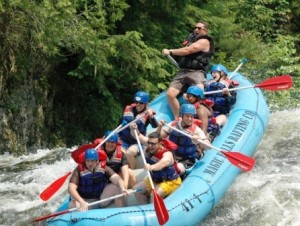 Kennebec & Moose River Valleys. River towns, lakes, mountains, and forests. Outdoor adventure, scenic splendor, history, and culture. Whitewater rafting and snowmobiling. Nationally known museums, Shakespearean theater, Maine’s capital city, and an international heritage corridor. The Appalachian Trail crosses this area about 60 miles north of Augusta near The Forks, Maine’s white-water rafting mecca; the 12-mile Kennebec River trip begins on Indian Pond and roars through the spectacular Upper Kennebec Gorge, with rapids up to class IV. The even more challenging Dead River provides the longest stretch of continuous whitewater in the East. The town of Skowhegan is about 40 miles north of Augusta on the Kennebec; it’s the home of the first female US Senator in the country, Margaret Chase Smith; there’s a library/museum about her life. Waterville, about 20 miles north of Augusta on the Kennebec, is home to the Waterville
Kennebec & Moose River Valleys. River towns, lakes, mountains, and forests. Outdoor adventure, scenic splendor, history, and culture. Whitewater rafting and snowmobiling. Nationally known museums, Shakespearean theater, Maine’s capital city, and an international heritage corridor. The Appalachian Trail crosses this area about 60 miles north of Augusta near The Forks, Maine’s white-water rafting mecca; the 12-mile Kennebec River trip begins on Indian Pond and roars through the spectacular Upper Kennebec Gorge, with rapids up to class IV. The even more challenging Dead River provides the longest stretch of continuous whitewater in the East. The town of Skowhegan is about 40 miles north of Augusta on the Kennebec; it’s the home of the first female US Senator in the country, Margaret Chase Smith; there’s a library/museum about her life. Waterville, about 20 miles north of Augusta on the Kennebec, is home to the Waterville 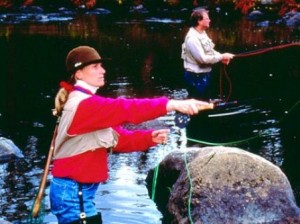 Opera House, the Colby College Museum of Art, and the Maine International Film Festival; many downtown buildings are listed on the National Register of Historic Places. There are miles of hiking trails throughout the area including the Quarry Roads Trail, great for winter snowshoeing. Just 10 miles north of Augusta around Belgrade a chain of seven lakes range in size from 500 to 8,000 acres; from Blueberry Hill see Long Pond, Great Pond, Belgrade Lakes Village; see deer, moose, birds. Hike, swim, or fish; catch Brown Trout, Largemouth Bass, Smallmouth Bass, White Perch, Pickerel, Northern Pike.
Opera House, the Colby College Museum of Art, and the Maine International Film Festival; many downtown buildings are listed on the National Register of Historic Places. There are miles of hiking trails throughout the area including the Quarry Roads Trail, great for winter snowshoeing. Just 10 miles north of Augusta around Belgrade a chain of seven lakes range in size from 500 to 8,000 acres; from Blueberry Hill see Long Pond, Great Pond, Belgrade Lakes Village; see deer, moose, birds. Hike, swim, or fish; catch Brown Trout, Largemouth Bass, Smallmouth Bass, White Perch, Pickerel, Northern Pike.
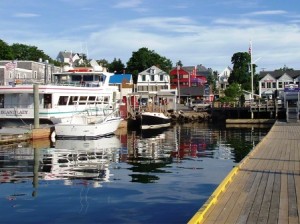 Mid-Coast. Scenic bays, craggy peninsulas, sparkling offshore islands. Picture-perfect fishing villages, seaside resorts, bustling harbor towns. Whale and puffin watching, biking, sea kayaking; world-class seafood. It’s less than 40 miles south from Augusta to Boothbay Harbor, the Gulf of Maine, and the Atlantic Ocean. Boothbay and Boothbay Harbor are quintessential New England maritime villages; Boothbay Harbor boasts the largest fleet of excursion boats in Maine for viewing lighthouses, islands, seals, whales, and puffins; there are charter boats for deep-sea fishing. Antique shops, boutiques, art galleries and gift shops; a championship public golf course at Boothbay Country Club; the Maine State Aquarium. Islands, inlets, state parks for camping and access to the sea – Moose Point, Warren Island, Camden Hills, Owls Head, Birch Point, Reid, Popham Beach.
Mid-Coast. Scenic bays, craggy peninsulas, sparkling offshore islands. Picture-perfect fishing villages, seaside resorts, bustling harbor towns. Whale and puffin watching, biking, sea kayaking; world-class seafood. It’s less than 40 miles south from Augusta to Boothbay Harbor, the Gulf of Maine, and the Atlantic Ocean. Boothbay and Boothbay Harbor are quintessential New England maritime villages; Boothbay Harbor boasts the largest fleet of excursion boats in Maine for viewing lighthouses, islands, seals, whales, and puffins; there are charter boats for deep-sea fishing. Antique shops, boutiques, art galleries and gift shops; a championship public golf course at Boothbay Country Club; the Maine State Aquarium. Islands, inlets, state parks for camping and access to the sea – Moose Point, Warren Island, Camden Hills, Owls Head, Birch Point, Reid, Popham Beach.
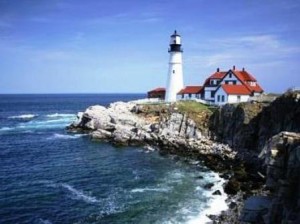 Greater Portland & Casco Bay. Historic seaport. Maine’s largest urban area. Accessible islands, coastal communities. Vibrant arts and entertainment scene. Walking and biking trails. Renowned cuisine. It’s about 55 miles southwest from Augusta to Portland and Casco Bay. Along the waterfront are walking trails, trolley tours, bay cruises, lobster-boat rides, historic schooners, island ferries, pubs, seafood restaurants, and stunning bay views. Cobblestone streets in the Old Port; boutiques, galleries and restaurants in renovated historic buildings. The Portland Museum of Art, the Children’s Museum of Maine. The Portland Freedom Trail; 16 historic sites explain the state’s role in the abolitionist movement. Eagle Island; cruise to the summer estate of arctic explorer Admiral Robert E Peary. Cape Elizabeth; Portland Head Light, Maine’s oldest lighthouse, first lit in 1791. Freeport and the world-famous L L Bean are 40 miles southwest of Augusta; retail shopping and outlet stores.
Greater Portland & Casco Bay. Historic seaport. Maine’s largest urban area. Accessible islands, coastal communities. Vibrant arts and entertainment scene. Walking and biking trails. Renowned cuisine. It’s about 55 miles southwest from Augusta to Portland and Casco Bay. Along the waterfront are walking trails, trolley tours, bay cruises, lobster-boat rides, historic schooners, island ferries, pubs, seafood restaurants, and stunning bay views. Cobblestone streets in the Old Port; boutiques, galleries and restaurants in renovated historic buildings. The Portland Museum of Art, the Children’s Museum of Maine. The Portland Freedom Trail; 16 historic sites explain the state’s role in the abolitionist movement. Eagle Island; cruise to the summer estate of arctic explorer Admiral Robert E Peary. Cape Elizabeth; Portland Head Light, Maine’s oldest lighthouse, first lit in 1791. Freeport and the world-famous L L Bean are 40 miles southwest of Augusta; retail shopping and outlet stores.
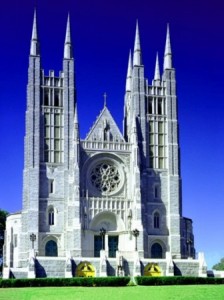 Lakes & Mountains. Mountain ranges, glacial lakes, creative communities. Outdoor adventures, wildlife watching, autumn foliage, historic sites. Stunning vistas, scenic byways. Skiing, snowboarding, snowmobiling. Less than 40 miles northwest of Augusta is the college town of Farmington and a U of Maine campus; the liberal arts college attracts writers, artists, musicians, educators, scientists and business experts to teach, speak, or perform. The twin cities of Lewiston and Auburn are 35 miles southwest of Augusta on the Androscoggin River; both have walkable downtowns; the Androscoggin River Walk stretches from the Great Falls in Auburn to Simard-Payne Memorial Park in Lewiston. The Basilica of Saints Peter and Paul was modeled after the cathedral at Chartres in France; Thorncrag Nature Sanctuary has bird watching, walking or jogging through forest and fields;
Lakes & Mountains. Mountain ranges, glacial lakes, creative communities. Outdoor adventures, wildlife watching, autumn foliage, historic sites. Stunning vistas, scenic byways. Skiing, snowboarding, snowmobiling. Less than 40 miles northwest of Augusta is the college town of Farmington and a U of Maine campus; the liberal arts college attracts writers, artists, musicians, educators, scientists and business experts to teach, speak, or perform. The twin cities of Lewiston and Auburn are 35 miles southwest of Augusta on the Androscoggin River; both have walkable downtowns; the Androscoggin River Walk stretches from the Great Falls in Auburn to Simard-Payne Memorial Park in Lewiston. The Basilica of Saints Peter and Paul was modeled after the cathedral at Chartres in France; Thorncrag Nature Sanctuary has bird watching, walking or jogging through forest and fields;  Lake Auburn is a favorite fishing hole for bass and lake trout; Mount Apatite Park is where rock hounds discover minerals like feldspar and tourmaline; Lost Valley ski area is the only city ski mountain in Maine.
Lake Auburn is a favorite fishing hole for bass and lake trout; Mount Apatite Park is where rock hounds discover minerals like feldspar and tourmaline; Lost Valley ski area is the only city ski mountain in Maine.
DownEast & Acadia. Picturesque harbors, classic fishing villages. Recreation, wildlife watching, relaxation. The first sunrise in the United States. As the crow flies, Acadia National Park is within the 50-mile circle around Augusta, but the drive is actually about a hundred miles around all the inlets and bays. Bar Harbor, (aka Bah Hah-bah) was New England’s premier summer resort in the 19th century, home to the largest hotel in North America and to Millionaires’ Row, summer estates built for America’s richest families – the Rockefellers, Fords, Vanderbilts, Carnegies, Astors and Morgans; some of the mansions now operate as inns. Acadia National Park is home to 1,532-foot Mount Cadillac; the park’s loop road is open to cars; the historic carriage roads allow no car traffic. Walk, 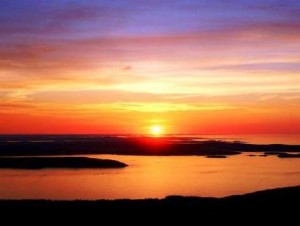 hike, rock climb, sail, paddle, golf, shop; family activities include a nature camp, oceanarium, zoo, and a lumberjack show. For that first US sunrise every morning, it’s Cadillac Mountain in the fall and winter; during most of spring and summer it’s Mars Hill; around the equinoxes it’s Lubec, the easternmost town in the US, about 200 miles east from Augusta.
hike, rock climb, sail, paddle, golf, shop; family activities include a nature camp, oceanarium, zoo, and a lumberjack show. For that first US sunrise every morning, it’s Cadillac Mountain in the fall and winter; during most of spring and summer it’s Mars Hill; around the equinoxes it’s Lubec, the easternmost town in the US, about 200 miles east from Augusta.
Think about it. Maine is where the sun first rises on the United States every morning. There is much more to Maine than I’ve covered in this post – I only touched on a 50-mile circle around Augusta. Maine has the mountains, the shorelines, the food, the history, the recreation, the arts, the spirit, the excitement, the peace and quiet. I mean, seriously. Maine ticks all the boxes.
Maine: The way life should be. http://www.visitmaine.com/
